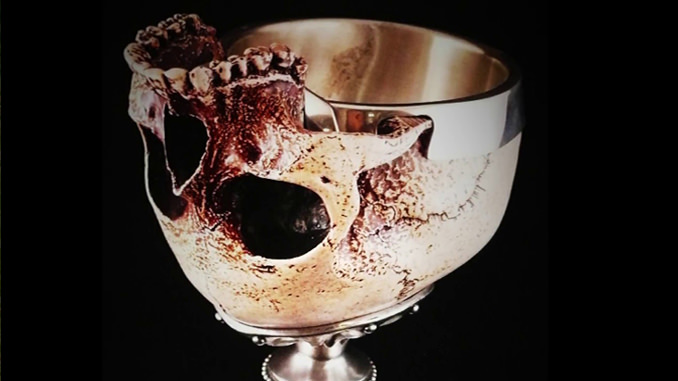

Kali with her four arms carries a sword, a trident, a severed head and a bowl with which to catch the blood. The bowl is known as a “Kapala” its a human skull which in tantric traditions is used as a drinking vessel for religious rites.
In Europe the Celtic warriors severed the heads of their opponents and their skulls were also used as drinking vessels for religious rites. The Germanic tribes and the Scythians also severed the heads of their opponents, using their skulls as drinking vessels they believed they would take on the courage of the slain warrior.
This drinking vessel is known as “Kapala” meaning “cup” “head” “bowl” “skull”. Its definitions describe how a skull was also a drinking vessel. In Europe we find the same thing as “Kapala” is reflected as the Danish “Kop” meaning “head” “cup”, the Dutch “Kopje” meaning “head” “cup”, the German “Kopf” meaning “head” “cup” “bowl”, the Old Frissian “Kopp” meaning “head” “cup” and the Anglo Saxon “Hafala” meaning “head” “cup” all of which not only reflect linguistic similarities but also shared cultural traits.
Throughout the world we see this Sanskrit “Kapala” reflected in many languages – Sanskrit – Kapala – Indonesia – Kepala – Malaysia – Kepala – Greek – Kephale – Dutch – Kap – Latin – Caput – German – Kopf – Africa – Kop – Italy – Capo – Czech – Cepel – Romanian – Capat – Spanish – Copa – Bulgaria – Kapital – Russian – Kapital – French – Chapiteau – Polish – Czapka – All meaning “head” and all from this Sanskrit “Kapala” meaning “head”.
So the conclusion is that in Vedic India we have a skull which is used also as a drinking vessel in religious rites and in Europe we also have a skull which is used as a drinking vessel in religious rites. In Sanskrit this drinking vessel is known as “Kapala” meaning “cup” “head” and in Europe this drinking vessel is known as “Kop” “Kopje” and “Kopf” meaning the same “head” and “cup”.
From this Sanskrit “Kapala” meaning “head” comes words such as “Captain” “Capital” “Chief” “Cup” “Cadet” and also the English word “Gable” as in the “gable end” which originally means “head” as in the “top of the house” the “roof of the house” the “head of the house”.
In his book “A Gothic Etymological Dictionary” linguist Winfred Philipp Lehmann writes “The shift of meaning from “vessel” to “skull” to “head” is in fact quite common and can be seen in the nouns “tete” in French and “kopf” in German. They once meant something like “bowl” or “vessel” but today only the meaning “head” has survived.”
John Aytos “Dictionary of Word Origins” says “the ancient Indo/European root of “head” ( Kaupet ) probably had connotations of “bowl” as well as “head” though its not clear which came first”.
